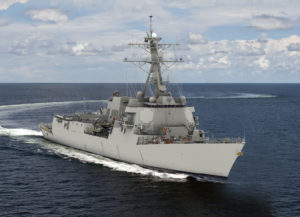A top Navy official this week said the service intends to buy at least two Flight III Arleigh Burke-class (DDG-51) destroyers while developing the next large surface combatant ship, the DDG(X).
Rear Adm. Paul Schlise, director of the Surface Warfare Division (OPNAV N96), said his first priority is delivering the Flight III DDG-51 ships on time, but his second highest priority is budgeting for two new large surface combatants per year.
“My next priority is related to the first and that is to budget for and build two large surface combatants a year, at a minimum. Two ships a year with a 35 to 40-year service life results in an objective force of 70 to 80 large surface combatants in our Navy,” Schlise said during an American Society of Naval Engineers (ASNE) symposium on Feb. 2.
“As N96 I will continue to make the case for our surface shipbuilding priorities to include two large surface combatants a year and we need to transition from Flight IIIs to DDG(X),” he added.
Schlise underscored that “two ships a year provides the Navy with the multi-domain dominance it needs to support the security and prosperity of the United States and it ensures the health of our large shipbuilding industrial base, something that I cannot stress enough. Strategic competition requires industrial might and we must take steps to ensure this capability is sustained.”
Schlise said the DDG-51 Flight III destroyers are very capable and “will pack considerable combat punch, but they are a bridge to the future, they are not the future itself.”
He reiterated the common Navy points in explaining the need to move from Flight III DDG-51s to DDG(X) in that the former fits as much capability as possible within the Arleigh Burke-class hull form and there is no remaining margin for growth.

“Remember, this hull was designed in the ‘80s. With DDG(X) we’re designing in margins, space weight power and cooling, or SWAP-C, to accommodate future capabilities. Capabilities that are under development today and which will be proven through intense, land-based testing and on other platforms already in service.”
Schlise said if the Navy waited for every capability to fully mature before moving on to DDG(X), “we might not be bending metal on DDG(X) for decades and we’d be marking time while our adversaries moved forward.”
He argued DDG(X) is the culmination of Navy lessons learned from past programs and that rather than tying the success of the next large surface combatant to developmental technology, “we’re using known, mature technologies on a flexible platform that can be upgraded for decades to come, as the technology of tomorrow becomes more proven and mature.”
Schlise argued DDG(X) will be “an evolutionary ship, not revolutionary.”
Last month, the Navy revealed the draft capabilities it is drawing up for the DDG(X) to eventually accommodate over time. This includes potentially adding directed energy laser weapons, hypersonic missiles and a more powerful radar to the ship in future upgrades (Defense Daily, Jan. 13).
He also said his third priority is delivering the Constellation-class frigates on time with plans to grow the class to build “at least two ships a year, hopefully more.”
Schlise said he is convinced the new frigates will “punch well above their weight class.”